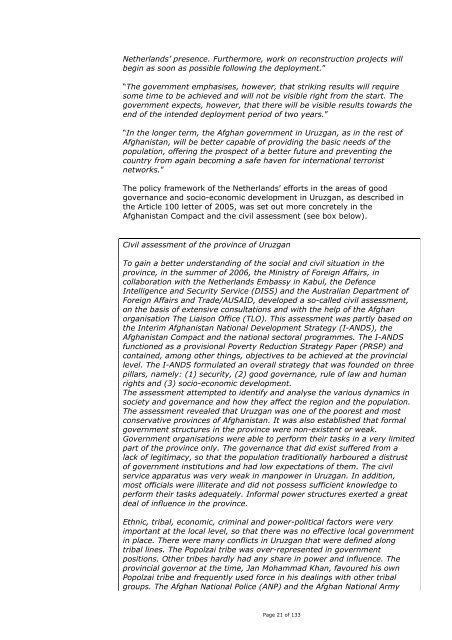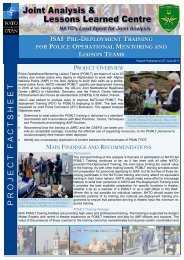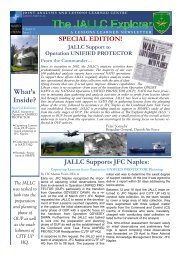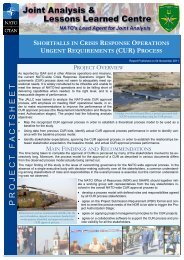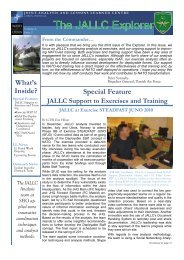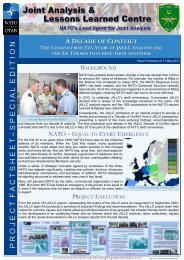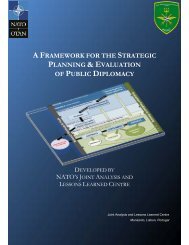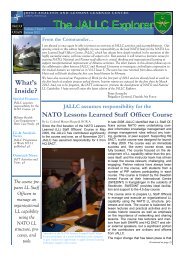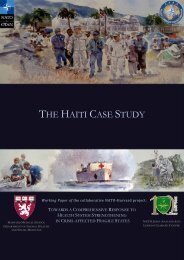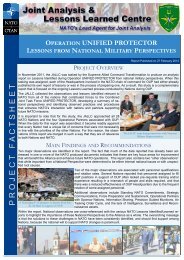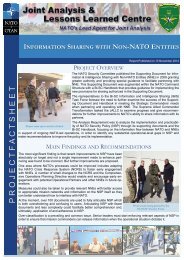Final evaluation Netherlands participation in ISAF 2006 - 2010
Final evaluation Netherlands participation in ISAF 2006 - 2010
Final evaluation Netherlands participation in ISAF 2006 - 2010
Create successful ePaper yourself
Turn your PDF publications into a flip-book with our unique Google optimized e-Paper software.
<strong>Netherlands</strong>’ presence. Furthermore, work on reconstruction projects willbeg<strong>in</strong> as soon as possible follow<strong>in</strong>g the deployment.”“The government emphasises, however, that strik<strong>in</strong>g results will requiresome time to be achieved and will not be visible right from the start. Thegovernment expects, however, that there will be visible results towards theend of the <strong>in</strong>tended deployment period of two years.”“In the longer term, the Afghan government <strong>in</strong> Uruzgan, as <strong>in</strong> the rest ofAfghanistan, will be better capable of provid<strong>in</strong>g the basic needs of thepopulation, offer<strong>in</strong>g the prospect of a better future and prevent<strong>in</strong>g thecountry from aga<strong>in</strong> becom<strong>in</strong>g a safe haven for <strong>in</strong>ternational terroristnetworks.”The policy framework of the <strong>Netherlands</strong>’ efforts <strong>in</strong> the areas of goodgovernance and socio-economic development <strong>in</strong> Uruzgan, as described <strong>in</strong>the Article 100 letter of 2005, was set out more concretely <strong>in</strong> theAfghanistan Compact and the civil assessment (see box below).Civil assessment of the prov<strong>in</strong>ce of UruzganTo ga<strong>in</strong> a better understand<strong>in</strong>g of the social and civil situation <strong>in</strong> theprov<strong>in</strong>ce, <strong>in</strong> the summer of <strong>2006</strong>, the M<strong>in</strong>istry of Foreign Affairs, <strong>in</strong>collaboration with the <strong>Netherlands</strong> Embassy <strong>in</strong> Kabul, the DefenceIntelligence and Security Service (DISS) and the Australian Department ofForeign Affairs and Trade/AUSAID, developed a so-called civil assessment,on the basis of extensive consultations and with the help of the Afghanorganisation The Liaison Office (TLO). This assessment was partly based onthe Interim Afghanistan National Development Strategy (I-ANDS), theAfghanistan Compact and the national sectoral programmes. The I-ANDSfunctioned as a provisional Poverty Reduction Strategy Paper (PRSP) andconta<strong>in</strong>ed, among other th<strong>in</strong>gs, objectives to be achieved at the prov<strong>in</strong>ciallevel. The I-ANDS formulated an overall strategy that was founded on threepillars, namely: (1) security, (2) good governance, rule of law and humanrights and (3) socio-economic development.The assessment attempted to identify and analyse the various dynamics <strong>in</strong>society and governance and how they affect the region and the population.The assessment revealed that Uruzgan was one of the poorest and mostconservative prov<strong>in</strong>ces of Afghanistan. It was also established that formalgovernment structures <strong>in</strong> the prov<strong>in</strong>ce were non-existent or weak.Government organisations were able to perform their tasks <strong>in</strong> a very limitedpart of the prov<strong>in</strong>ce only. The governance that did exist suffered from alack of legitimacy, so that the population traditionally harboured a distrustof government <strong>in</strong>stitutions and had low expectations of them. The civilservice apparatus was very weak <strong>in</strong> manpower <strong>in</strong> Uruzgan. In addition,most officials were illiterate and did not possess sufficient knowledge toperform their tasks adequately. Informal power structures exerted a greatdeal of <strong>in</strong>fluence <strong>in</strong> the prov<strong>in</strong>ce.Ethnic, tribal, economic, crim<strong>in</strong>al and power-political factors were veryimportant at the local level, so that there was no effective local government<strong>in</strong> place. There were many conflicts <strong>in</strong> Uruzgan that were def<strong>in</strong>ed alongtribal l<strong>in</strong>es. The Popolzai tribe was over-represented <strong>in</strong> governmentpositions. Other tribes hardly had any share <strong>in</strong> power and <strong>in</strong>fluence. Theprov<strong>in</strong>cial governor at the time, Jan Mohammad Khan, favoured his ownPopolzai tribe and frequently used force <strong>in</strong> his deal<strong>in</strong>gs with other tribalgroups. The Afghan National Police (ANP) and the Afghan National ArmyPage 21 of 133


